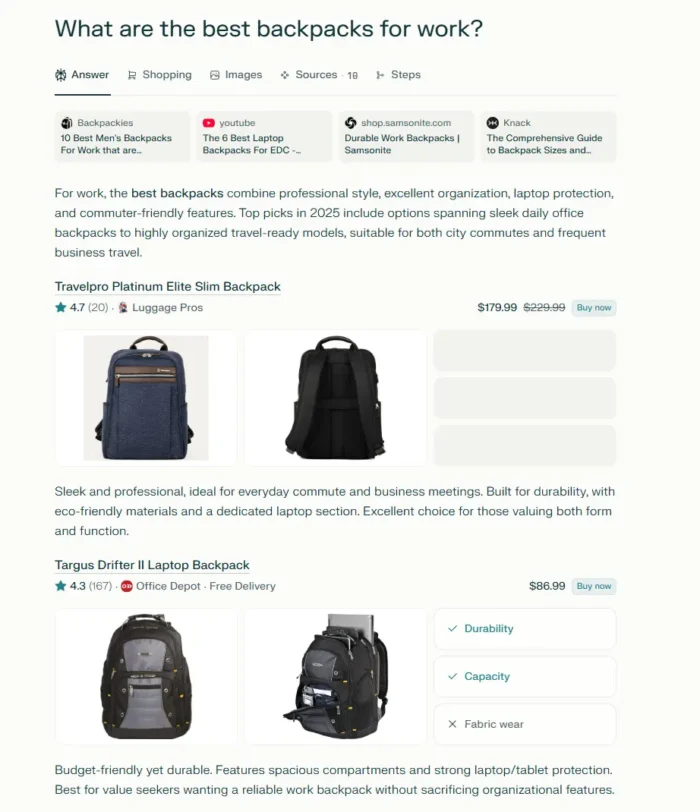Improve Rankings With This Off-Page SEO Checklist For Restaurants via @sejournal, @andreeaa_voicu
Tick all the items on this off-page SEO checklist for restaurants to increase your eatery's online visibility and rank higher in search. The post Improve Rankings With This Off-Page SEO Checklist For Restaurants appeared first on Search Engine Journal.

In 2022, having an online presence for your restaurant business is essential.
When looking for new places to eat, people turn to search for thousands of results at their fingertips – and the competition is fierce.
If you want locals to find your restaurant while searching for places to eat in the area, you need to work on your online presence and appear prominently in those search results.
Search engine optimization (SEO) is one of the best and most affordable ways to distinguish your restaurant online.
While on-page SEO is all about optimizing your website, off-page SEO focuses on spreading your reach online.
Below, you will find an off-page SEO checklist for restaurants featuring all the elements you need to keep track of regularly.
You will learn about Google My Business, TripAdvisor, Yelp, social media, link building, and more.
1. Claim Your Google Business Profile
Google Business Profile (GBP), formerly known as Google My Business, is one of the most powerful tools for businesses everywhere.
It allows owners to increase their business’ visibility on Google and make a good first impression by highlighting what makes them unique.
Whatever information you decide to highlight is what customers will see when searching for your restaurant or restaurants near them on Google.
If you want your customers to find your restaurant on Google Search and Google Maps, you need to claim and fill out your Google Business Profile.
The more information you add about your restaurant, the bigger the chances of hungry customers finding it.
Your restaurant website is the most crucial element you need to add to Google My Business.
It will bring you an incredibly valuable free backlink and make it easy for people to navigate to your website.
Equally important for business is displaying your menu and order page.
Additional must-have Google My Business information includes:
Location. Opening hours. Contact information. Photos of your dishes and the restaurant ambiance.To make your GMB profile more attractive, showcase your daily specials, promotions, events, and behind-the-scenes videos.
If you have multiple restaurant locations, it’s good practice to have a separate Google My Business profile for each.
2. Claim Your Profiles On Yelp And TripAdvisor
Yelp and TripAdvisor are both a close second on this off-page restaurant SEO checklist.
According to a BrightLocal survey, 98% of customers read online reviews of businesses in 2021.
Websites such as TripAdvisor and Yelp are visited by millions of consumers every month.
Naturally, that’s where your restaurant needs to be.
Add your restaurant to TripAdvisor and Yelp, or claim your listing if it’s already there.
Yelp For Restaurants
After you fill in your basic information, follow these steps to customize your Yelp profile and stand out in the crowd:
Add your menu. Provide additional information on your services, like delivery, table reservations, and online payment methods. Add a restaurant description that you optimize with relevant keywords such as “Italian restaurant,” “pizza,” or “New York” – access this guide to learn how to do keyword research. Add the Yelp badge to your restaurant website. Grow your Yelp rating by encouraging reviews and filling in your profile 100%. Add a call-to-action button that redirects customers to your website.TripAdvisor For Restaurants
The rules above apply to TripAdvisor, too.
Start by filling in profile basics like name, address, and website.
Next, take your profile to the next level with these tips on how to rank higher on TripAdvisor:
Collect reviews and reply promptly (starting with the negative ones). Keep your listing up to date. Order branded TripAdvisor stickers to decorate your windows. Set up direct messaging so customers can contact you directly. (This can help you solve complaints without affecting your public reviews). Create a Storyboard where you showcase your best photos and reviews.3. Link Your Website On Social Media
Social media is another vital aspect of off-page SEO for restaurants. While it’s not a direct ranking factor, it can still indirectly influence SEO.
How? Having your social media profiles redirect to your website will bring you additional traffic and business, and build your authority online.
However, having the profiles isn’t enough.
You must have an active presence and interact with your followers to encourage them to share your content.
Each social network has its function.
On Facebook, you can post your menu using the ‘Start Order’ button to actively boost sales.
Instagram is where your dishes will shine. Post photos that your followers won’t be able to resist.
Twitter is an excellent place to address customer concerns.
Use it to update followers on opening hour changes, new menu items, events, and anything else they might want to know.
While Facebook, Instagram, and Twitter are the holy trinity of social media platforms, there are other platforms you can leverage that can wield surprising results, such as Pinterest, Snapchat, or TikTok.
On Pinterest, you can post delicious photos of your menu, link to your website, create recipe boards, interact with other people in the restaurant industry, and create exclusive giveaways.
Snapchat can help you attract more local customers using geofilters and engaging your audience with little games and hidden discount codes in your stories.
Use TikTok to connect to a younger audience, create hashtag challenges, do funny skits and challenges, and take customers behind the scenes.
Don’t forget to add all your social media profiles to your website.
Use social media to share user-generated content too.
However, ensure you have your customers’ express permission to share their posts on your pages.
4. Do Link Building Outreach
Getting quality backlinks from high-authority websites can help improve your site’s authority, reputation, and search rankings.
Having your restaurant featured in local online publications will expose your business to new customers, as well.
First, look for high-rated websites in the food industry and approach them with a guest post pitch.
You can offer your knowledge as a chef or restaurant owner and include a link to your restaurant website in the article.
Next, find local business directories and get in touch to add your restaurant.
The same goes for websites that rank the best restaurants in an area.
Offer to include a discount code for their visitors to sweeten the deal.
Create A Restaurant Blog
If you want relevant websites to link to you naturally, consider opening a blog where you share your experience in the restaurant industry.
Remember to do keyword research to find topics that people are interested in reading about so your articles can rank high.
Here are some restaurant blog topic ideas you can explore:
How-tos and cooking guides (how to cook seafood, how to season rice, what wine goes with fish). Lists (X common kitchen ingredients, X dinner etiquette tips, X types of food for movie night). Menu, food, or industry trends (food trends 2022, restaurant trends 2022) Menu updates, limited items, and FAQs. New features or products (how to place an order online, how to book a table online, how to pay for your meal online). Pages about you and your staff (employee of the month, meet the owner, the story behind your restaurant).When looking for keywords, keep in mind your restaurant’s cuisine and key selling point.
If you own a vegetarian restaurant, for instance, you won’t be writing about “how to cut steak” but rather “vegetarian lunch box ideas” or “how to season vegetables for grilling.”
5. Collaborate With Food Influencers
Food bloggers and influencers with a social media following can be excellent promoters of your restaurant.
They can help boost traffic to your website and increase your search engine ranking by linking to your domain.
Invite local influencers for exclusive tastings of your newest menu items so they can post about them on their blogs and social media.
You can also provide their followers with a special discount coupon.
You can find local influencers on subreddits created by and for food bloggers or use tools like meetup.com to look for foodie groups meeting in your town.
Try paid blogger outreach software if you’re willing to invest more in blogger outreach.
6. Keep Your NAP Updated Throughout All Platforms
Consistency of NAP (name, address, phone number) is an important step in restaurant SEO and a must-have item on this off-page SEO checklist.
Your NAP information should be available on your website, social media, and third-party websites.
Search engines are particularly fond of this information, as it helps users find the answers to their questions.
For your restaurant information to be shown in relevant searches, you must display your NAP information and update it constantly across all platforms.
Make sure the information is spelled the same and is displayed in the same format.
Otherwise, it might confuse users and make you untrustworthy for search engines.
7. Add Your Restaurant On Popular Review Platforms And Business Directories
Once you’ve covered your bases with Google My Business, Yelp, and TripAdvisor, it’s time to research additional directories and websites where you can list your restaurant.
Some of these will help you get a valuable backlink, but all will expose you to new customers.
For example, Bing might not be as popular as Google, but it’s worth adding your restaurant to Bing Places.
Here are other websites where you should add your restaurant to boost off-page SEO:
Citysearch. Foursquare. Local.com. Yellowpages.com. White Pages.Remember the advice from the previous section – keep your NAP information consistent across all platforms.
Summary
Good food is just one element of your restaurant’s success.
Without a solid online presence, you can’t cater to today’s audience of food lovers.
Getting attention online starts with your website but continues with off-page restaurant SEO.
From social media to review websites and food blogs, check off all the items on this off-page SEO checklist to make your restaurant a fixture in the local community – and a dominant force in search results.
More Resources:
10 Quick SEO Tips to Boost Your Restaurant Website in Search 15 Reasons Why Your Business Absolutely Needs SEO SEO for Beginners: An Introduction to SEO BasicsFeatured Image: Monster Ztudio/Shutterstock

 JaneWalter
JaneWalter 
































